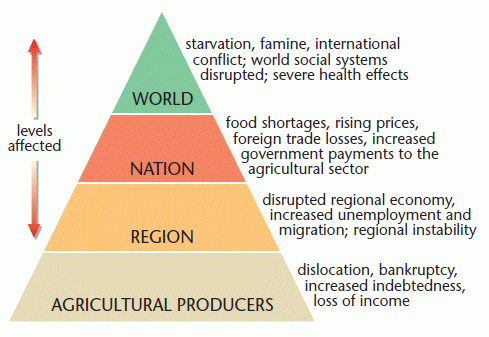Drought and its teleconnection to ENSO
ENSO occurrences are global climatic events linked to various climatic anomalies. Drought in particular has a strong teleconnection with ENSO.
Teleconnections are atmospheric reactions between widely separated regions.
The mechanism
Every two to seven years ocean currents and winds shift off the coast of western South America bringing warm water westward. In recent decades, scientists have recognised that El Niño, as it is called, is linked with shifts in global weather patterns. Its effects last between 14 and 22 months. The southern oscillation, ‘a seesaw of atmospheric pressure between the E Pacific and Indo-Australia’, is closely linked to El Niño. Generally El Niño refers to the oceanic properties and southern oscillation refers to the atmospheric component, see diagrams below:
The press is full of El Niño references – keep abreast of them.

Normal circulation: with southern oscillation

ENSO event: no southern oscillation
Amplification
Researchers have found that during an ENSO event drought can occur virtually anywhere in the world. Central America and various parts of the USA, the islands of the Pacific Basin and India all show strong relationships. E Australia, for example, has been subjected to abnormally dry conditions for much of the late 1990s, these dry conditions have decimated crops and caused bush fires (on a year to year basis since 1997 drought has cost Australia A$2 billion annually).
Drought is defined as an extended period of rainfall deficit during which biomass is curtailed.
CASE STUDIES - 1998 – ‘the hottest and driest year since 1866’ - Impacts around the globe show how drought affected countries with differing levels of development.
CASE STUDY - Florida - Dry weather and record heat; water restrictions in areas (e.g. Delton placing restrictions on outdoor water use such as washing cars and watering lawns); over 3600 ha burned in state-wide fires; the state banned all open burning; fire restrictions were put in force in national forests; firefighting teams were brought in from Georgia, Arkansas and Alabama.
CASE STUDY - New Zealand- Summer drought and economic problems from the Asian crisis; 1 in 100 year drought in the Wairarapa/Tararua area; 7.1% unemployment in the first quarter of 1998 (129 000 people – up 7 000 from the previous quarter and 13 000 more than a year ago); drought affected farming and ranching activities.
CASE STUDY - Indonesia - Drought and economic crises (although, recent rains have eased the situation); 40 million people live under chronic marginal circumstances (8 million people at risk of food shortage); A$50 million in humanitarian aid (grain, medical supplies, feeding and agricultural programmes, drought co-ordination, and employment programmes) and a $1 billion loan fund was made available by Australia.
CASE STUDY - Nepal - Malnutrition and diseases (influenza, cold, fever, dysentery, and diarrhoea) in the Humla district brought on by poor harvest now caused by drought (some of the diseases have now been brought under control).
CASE STUDY - Namibia - Drought in the north east; 25 000 people needed food aid in Caprivi and Kavango regions (these families did not plant in 1998 because of drought conditions).
Summary
Being able to forecast and anticipate droughts (they are termed slow onset hazards) would be useful as the 100 or so countries that continue to have long periods of drought experience severe consequences to their social and economic development, because of this hazard.

